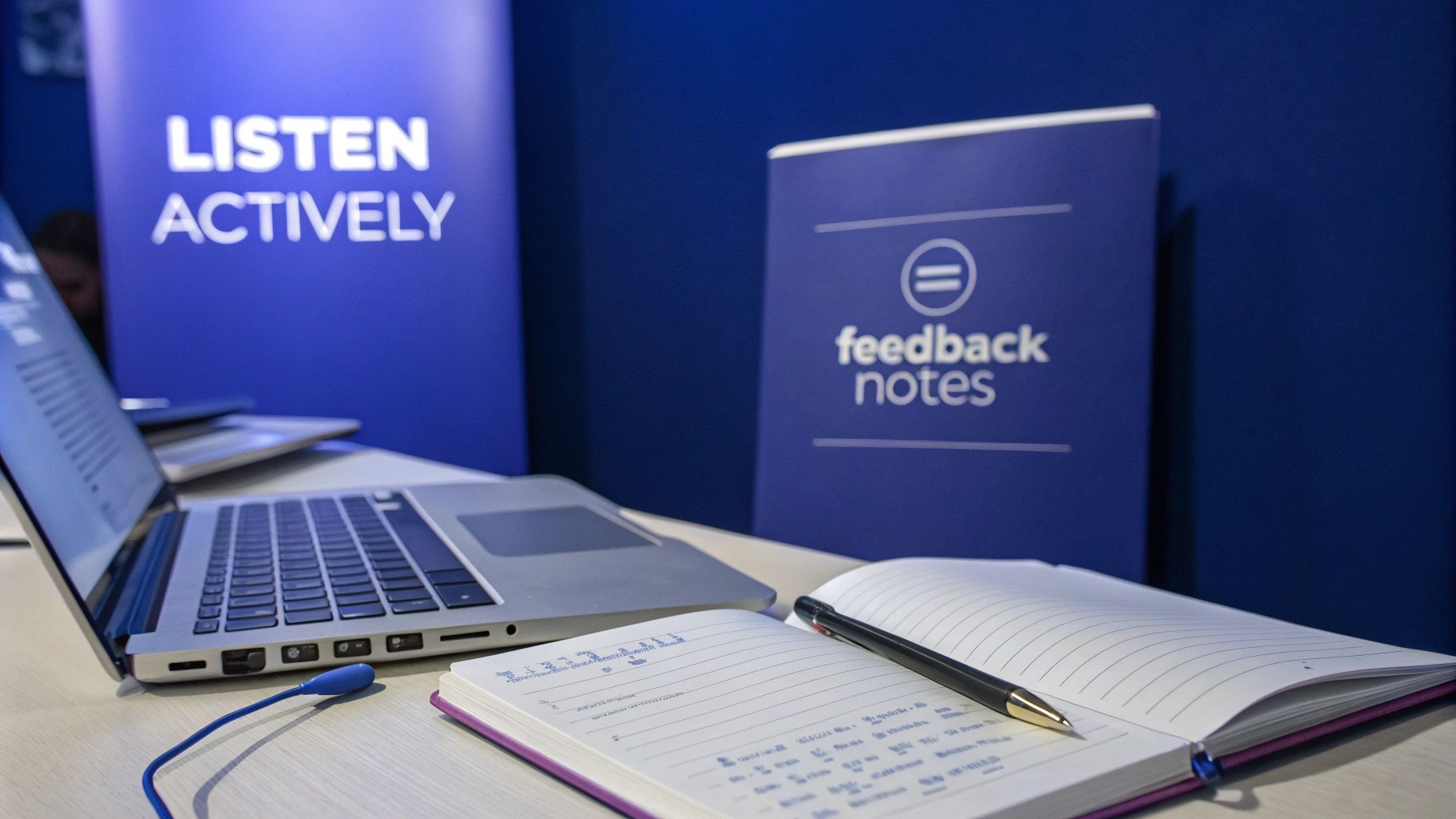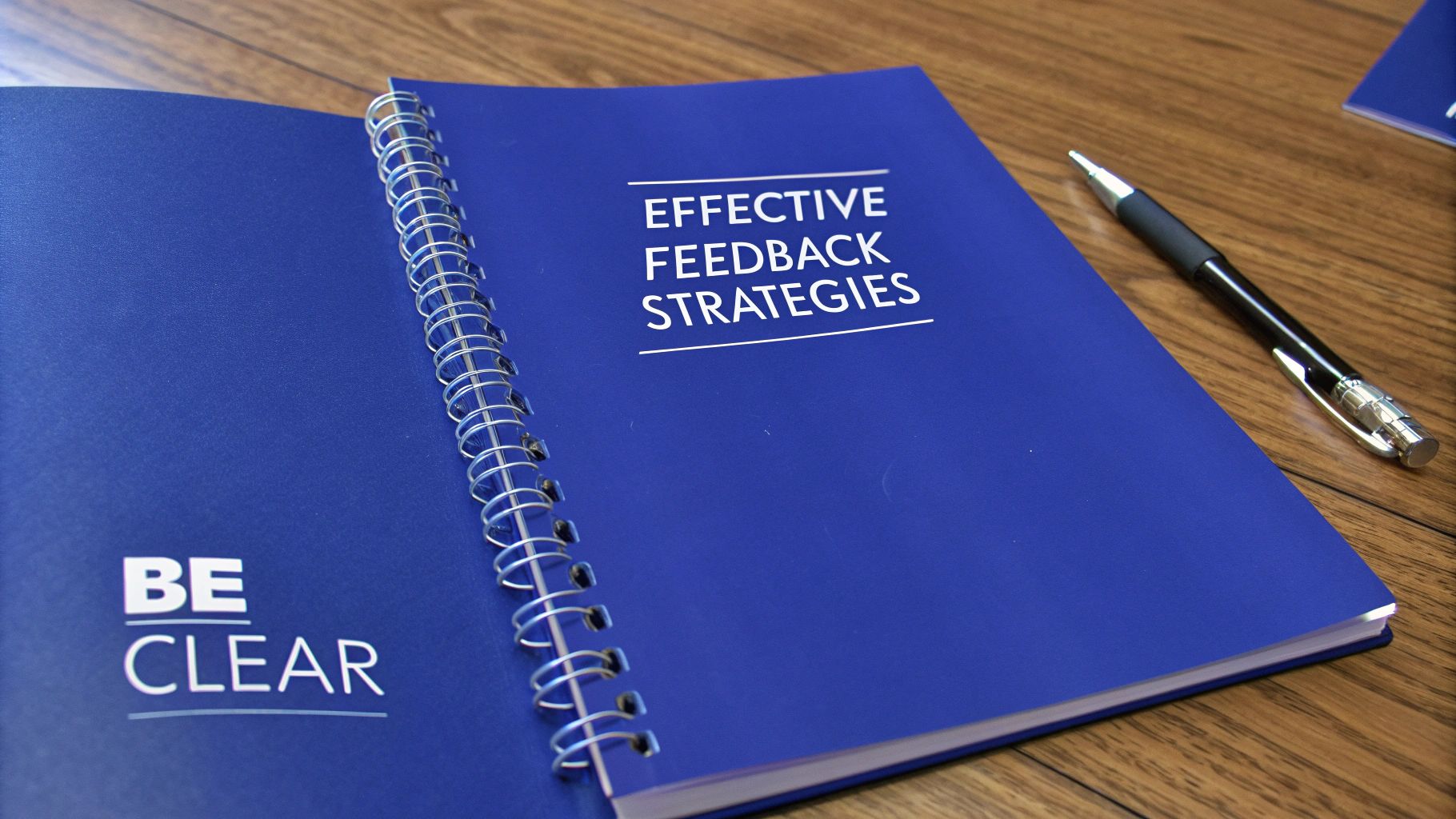Why Traditional Feedback is Failing in Today's Workplace

The way companies give feedback isn't working anymore. Annual reviews and generic surveys fall flat because they don't match how people actually want to receive and act on feedback. Companies that stick to these outdated approaches miss valuable chances to boost performance and help their employees grow.
The Problem with Infrequent, Delayed Feedback
Waiting months to give feedback seriously reduces its impact. When managers save their comments for annual reviews, employees struggle to connect that feedback to specific situations or behaviors. For example, discussing a project from six months ago makes it hard for someone to remember exactly what happened and learn from it. This long gap between actions and feedback also builds unnecessary stress around review time, making the whole process less effective.
The Importance of Specificity and Actionability
Generic feedback like "needs improvement" leaves employees confused and frustrated. They want to know exactly what to fix and how to fix it. Good feedback points to specific examples and outlines clear next steps. For instance, instead of just saying "your presentations need work," helpful feedback might explain "Your key points got lost because there was too much text on each slide. Try limiting slides to 3-4 bullet points and using more visuals to support your message."
The Rise of Real-Time Feedback and Technology
Smart companies are switching to better ways of giving feedback. Tools like Slack allow teams to share thoughts and suggestions as work happens. Platforms like BugSmash let people give precise feedback on creative work by commenting directly on files. Quick pulse surveys help track how employees feel throughout the year. These tools make it easier to give helpful feedback right when it matters most.
Creating a Culture of Continuous Improvement
The best feedback happens through regular conversations, not just formal reviews. When managers and employees check in often and talk openly, people feel supported in their growth. Clear, timely, and specific feedback helps everyone understand what's working and what needs to change. This ongoing dialogue creates an environment where people want to improve and know exactly how to do it. Making feedback a natural part of work, rather than a dreaded annual event, helps both individuals and organizations succeed.
Building Real-Time Feedback That People Actually Want
Gone are the days when annual reviews and suggestion boxes were enough. Smart organizations are now creating feedback systems their people genuinely want to use. By making feedback part of everyday work rather than a formal event, companies help their teams grow continuously through natural conversations.
The Power of Micro-Feedback Moments
Quick, casual feedback exchanges work far better than waiting for formal reviews. For example, right after a presentation, a manager might say "Great job explaining the key points clearly. Next time, try adding a few more examples to reinforce your message." These brief interactions let people improve right away and make feedback feel helpful rather than scary. Small pieces of feedback are also easier to put into practice, helping people build skills faster.
Integrating Feedback into Existing Workflows
The best feedback fits smoothly into the tools teams already use. Teams can give quick praise or suggestions through Slack, comment directly on work in Asana, or use tools like BugSmash to give specific visual feedback on designs. When feedback happens naturally within work tools, it stops feeling like an extra task and becomes a normal part of getting things done. This also keeps feedback connected to the actual work being discussed.
Fostering a Culture of Open Communication
For real-time feedback to work, people need to feel safe speaking up. Managers play a key role by actively asking for honest input, both positive and critical. Simple questions like "What's one thing we could do better?" or "How can I support you more effectively?" encourage open dialogue. When people see their input matters, they're more likely to share feedback and act on feedback they receive. This builds trust and makes feedback a two-way conversation.
Balancing Speed with Substance
While quick feedback is important, it still needs to be specific and actionative. Rather than just saying "good job," managers should explain what worked well and suggest clear improvements. For instance: "Your presentation was engaging and well-organized. For next time, consider adding more visuals to further illustrate your key points." By giving concrete details and suggestions, feedback becomes truly helpful for growth. Finding this balance between speed and substance makes real-time feedback a powerful tool for improving both individual and team performance.
Making Feedback Safe and Actionable

Creating an environment where people feel secure sharing honest thoughts drives meaningful improvement. When team members know they can speak up without fear of negative consequences, feedback becomes a powerful tool for positive change rather than a source of anxiety.
Creating Psychological Safety
The foundation for effective feedback is building trust and showing that all perspectives matter. Leaders set the tone by openly acknowledging their own areas for growth and actively seeking input from their teams. For instance, a manager might share a recent mistake and what they learned from it, then ask team members for suggestions on how to improve. Clear guidelines around giving and receiving feedback help create consistency and maintain respectful interactions.
Turning Vague Complaints into Actionable Insights
Generic feedback like "needs improvement" leaves people feeling frustrated and unsure how to change. Good feedback pinpoints specific behaviors and their impact. For example, rather than saying "your communication needs work," try: "During yesterday's project update, when key milestones weren't clearly outlined, the team wasn't sure about next steps. Walking through a structured agenda could help everyone stay aligned." This gives concrete examples and clear suggestions for improvement.
Delivering Tough Messages Constructively
Even in a supportive environment, giving critical feedback takes skill. One effective approach focuses on explaining the impact of behaviors rather than attacking the behaviors themselves. Instead of "you keep interrupting people," say "When conversations get interrupted, it makes it harder for everyone to fully share their ideas, which slows down our decision-making." This helps people understand why the change matters.
Real-World Examples and Best Practices
Many companies successfully handle sensitive feedback situations through proven methods. Some use anonymous tools to encourage candid input on tough topics. Others run regular pulse checks through platforms like SurveyMonkey to spot issues early. These real-time feedback loops provide quick insights for course correction. For more guidance, check out How to master effective feedback loops for your software team. By learning from what works, organizations create feedback systems that help everyone grow while maintaining psychological safety.
Using Technology While Keeping the Human Element

Tools and technology help power modern feedback, but one key principle remains: technology should make human connections stronger, not replace them. The goal is finding the right balance where digital tools enhance real conversations and relationships rather than getting in the way. Just having fancy software isn't enough – what matters is using it thoughtfully to support meaningful dialogue.
Picking Tools That Fit Your Team
With so many feedback platforms available, it's easy to get overwhelmed. Smart organizations stay focused on what their specific teams actually need. For instance, design teams often benefit from visual feedback tools like BugSmash for marking up designs, while sales teams may want something that connects to their customer database. This focused approach ensures tools serve a clear purpose and fit naturally into how people already work.
The Risks of Too Much Technology
While digital tools help gather and analyze feedback effectively, overdoing it creates problems. Automated systems can miss important context and nuance that comes from real conversations. Too many feedback requests can also lead to survey burnout, where people stop giving thoughtful responses. When used carelessly, technology can actually make feedback less authentic and valuable.
Keeping Feedback Personal in a Digital World
To avoid these issues, mix technology with genuine human interaction. For example, after running quick pulse surveys, follow up with one-on-one discussions to dig deeper into what people shared. Technology works best when it enables more personal connections – like making it easy to schedule regular check-ins or recognize coworkers' contributions.
Creating a Technology System That Works
Building strong feedback practices requires choosing tools strategically. Your technology should support the entire feedback process with tools like:
- Real-time feedback: Platforms like Slack for quick exchanges
- Performance tracking: Systems for monitoring goals and growth
- 360-degree feedback: Tools to gather input from multiple sources
- Surveys and polls: Platforms like SurveyMonkey for structured feedback
The key is selecting tools that work together smoothly and align with existing processes. This creates an environment where technology helps people give and receive feedback in ways that strengthen relationships and drive improvement. Finding the right mix of digital efficiency and human connection allows organizations to build feedback practices that lead to lasting positive change.
Creating Feedback Systems That Scale
When organizations grow beyond a certain size, one-on-one feedback conversations simply can't keep up. You need smart feedback systems that can grow alongside your team while maintaining high standards. Let's explore how to build these scalable feedback processes that actually work.
Training Managers for Effective Feedback Delivery
The foundation of any great feedback system starts with well-trained managers. Since managers interact with employees daily, they need specific skills to give feedback that drives positive change. For instance, rather than making statements like "You're disorganized," effective managers learn to say "I noticed the project deadline was missed – let's look at how we can improve the planning process next time." This approach focuses on specific behaviors and solutions rather than personal criticisms. Through proper training, managers become skilled at having tough conversations in ways that motivate rather than discourage.
Establishing Consistent Feedback Practices
Creating predictable feedback processes helps everyone know what to expect. You might be interested in: How to centralize team feedback. This means setting up regular check-in meetings, using standard feedback forms, and creating clear guidelines that all teams follow. When everyone understands how and when feedback happens, it becomes a normal part of work life rather than something to fear. Clear processes also ensure fairness across different teams and departments.
Maintaining Quality as Your Team Expands
As teams grow larger, keeping feedback meaningful becomes more challenging. Tools like SurveyMonkey help gather feedback from many people while ensuring quality and consistency. These platforms enable anonymous input, which often leads to more honest responses. They also make it easier to spot patterns and improvement areas across the whole organization. Research shows this matters – 68% of employees who receive regular feedback report feeling more satisfied with how their work connects to company goals.
Learning from Fast-Growing Companies
Many successful companies have already figured out how to scale their feedback systems effectively. Some use quick pulse surveys to keep tabs on employee satisfaction, while others create peer feedback programs to get input from multiple perspectives. By studying what works for these companies and adapting those approaches to your needs, you can build feedback practices that remain effective whether you have 10 employees or 10,000.
Measuring What Matters in Feedback

Having good feedback systems in place is essential, but understanding their real impact is what truly matters. While collecting feedback serves a purpose, the key lies in measuring concrete results and improvements. This means moving past simple metrics like feedback frequency to focus on meaningful indicators of progress. Let's explore proven ways to measure feedback that create real value.
Beyond Surface-Level Metrics
Getting lots of feedback submissions might look impressive, but quantity alone doesn't equal success. What truly matters is whether that feedback leads to better performance and outcomes. Focus on tracking specific improvements – are projects getting completed faster? Are customers more satisfied? Are employees staying longer? These data points show the actual return on your feedback investment by connecting input to concrete results.
Measuring Behavioral Change
Good feedback should spark positive changes in how people work. Look for evidence that teams are acting differently based on the input they receive. For instance, if feedback highlights communication gaps, check whether meeting notes show clearer discussions or if project documents reflect better information sharing. By monitoring specific behaviors, you can see if feedback translates into real workplace improvements.
Focusing on Business Outcomes
Your feedback efforts need to support key business goals. This means tracking how feedback initiatives affect your most important metrics. If improving customer experience is a priority, monitor whether satisfaction scores increase after implementing new feedback approaches. This direct link between feedback and results proves its worth and supports continued investment in feedback programs.
Practical Measurement Frameworks
Several tested frameworks can help structure your feedback measurement. A balanced scorecard approach looks at multiple areas:
- Learning and Growth: Track how employees develop through feedback by measuring training completion, mentoring participation, and skill advancement.
- Internal Processes: Monitor process improvements through efficiency gains, error reduction, and faster completion times.
- Customer Perspective: Gauge customer satisfaction through surveys, reviews, and retention rates.
- Financial Performance: Connect feedback to business results through revenue, profit, and ROI metrics.
Using frameworks like balanced scorecards gives you a complete view of feedback impact. Tools like SurveyMonkey make collecting and analyzing this data straightforward.
Remember that measuring feedback is an ongoing process. Keep refining your approach based on what the data tells you and what your organization needs. By staying flexible and responsive, you'll ensure your feedback practices drive meaningful growth.
Ready to improve how you collect and analyze feedback? Try BugSmash today and see the difference structured feedback management makes. Get started with BugSmash now!




